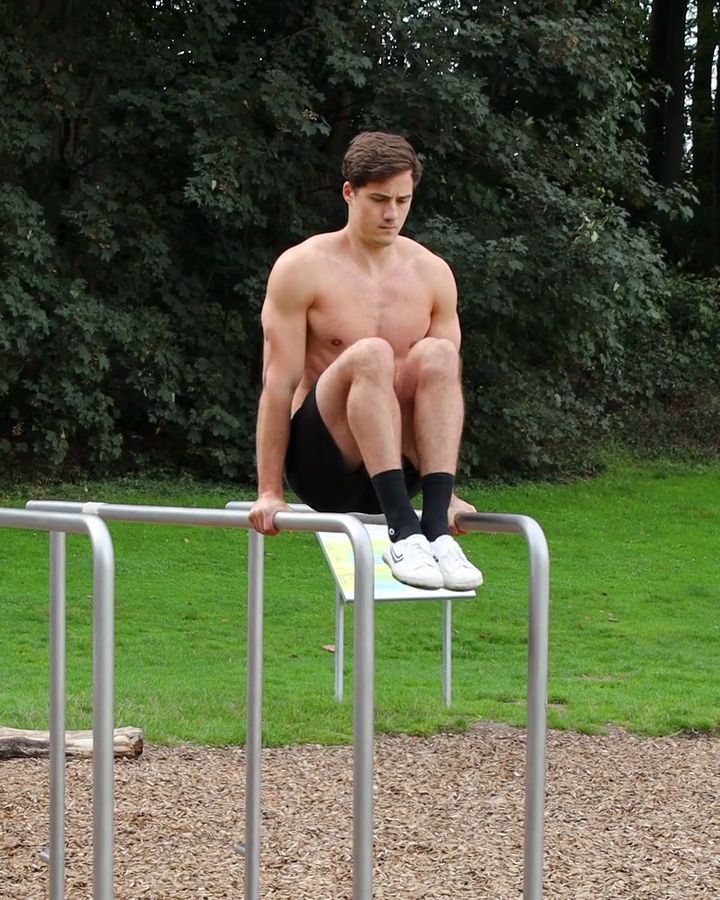Leg Raises on the rings
Leg raises on gymnastics rings are an excellent exercise for strengthening the abdominal muscles and hip flexors. The instability of the rings also engages the shoulders and deep core muscles, making the exercise particularly challenging. This exercise is ideal as preparation for the L-Sit.
Necessary equipment
Leg Raises on the rings - the correct execution
- Start in a support position with arms fully extended
- Keep your shoulders in a low and stable position
- Lift your legs straight until your feet are at least at ring height
- Lower your legs slowly and with control back to the support position
The exercise Leg Raises is intended to be used as a hypertrophy exercise.
Which muscles are trained by Leg Raises?
















Primary trained muscles for Leg Raises
Abs - The rectus abdominis, also known as the "abs," runs vertically along the front of the abdomen. It is responsible for bending the torso forward, such as during sit-ups, and lifting the pelvis. This muscle stabilizes the torso, supports the spine, and helps maintain good posture.
Hipflexors - The hip flexors, including the iliacus and psoas major muscles, allow you to bend your leg and torso forward.
Front Delts - The front part of the deltoid muscle, also known as the anterior shoulder, is located at the front of the shoulder. It is primarily involved in the forward movement of the arm, such as lifting the arm forward. It also assists in the internal rotation of the arm. This muscle is engaged in activities that involve lifting objects in front of the body or pushing forward.
Secondary trained muscles for Leg Raises
Quadriceps - The quadriceps femoris is the large muscle at the front of your thigh. It extends your knee.
Chest - The pectoralis major muscle is the large muscle on your chest. It helps you bring your arm towards your body and rotate it inward.
Latissimus - The latissimus dorsi is a large muscle in your back that helps you pull your arm down and back. It also supports breathing and stabilizes the spine.
Upper Back - The muscles in the upper back, including the trapezius and rhomboid muscles, help move and stabilize your shoulders. They pull the shoulder blades together and support posture.
Alternative variants of Leg Raises on the rings:
Leg Raises on parallel bars
A variation of this exercise is leg raises on parallel bars. The bars provide more stable support, allowing for a greater focus on precise movement execution. Shoulder stability is less of a factor, making the exercise slightly less challenging, but enabling a higher number of repetitions.
Necessary equipment

Leg Raises on parallel bars - the correct execution
- Start in a support position with straight arms
- Keep your shoulders in a low and stable position
- Raise your legs straight up until your feet are at least at the level of the pbars
- Flex your hips to 90 degrees
- Slowly and controlled, lower your legs back to the extended support position
Similar exercises to Leg Raises
One Leg L Sit
The One-Leg L-Sit on the parallettes is a challenging exercise that primarily targets the abdominal muscles, hip flexors, and supporting muscles. In this exercise, the athlete assumes an L-position, keeping one leg straight while bending the other. It requires a high level of body tension, strength, and balance.
The one-legged variation serves as a preparatory exercise for the classic L-Sit, where both legs are extended. Holding this position engages the abdominal muscles even more intensely.
An even easier progression is the Tuck L-Sit, where both legs are bent and pulled close to the body. This reduces the lever arm, making it easier to hold the position while still engaging the core and supporting muscles.
Assisted L Sit
In the supported L-Sit, the legs are extended with the heels resting on the ground. Compared to the regular L-Sit, where the legs are fully lifted off the ground, the supported version is ideal for beginners, as it requires less core strength while still preparing the upper body for the proper L-Sit. Another easier variation is the Tuck L-Sit, where the knees are drawn toward the chest.
Knee Raises on parallel bars
Knee raises primarily train the abdominal muscles and hip flexors, similar to the L-Sit or leg raises. During the exercise, the knee is pulled up to the chest while keeping the upper body upright. This exercise can be performed while standing or hanging from a pull-up bar.
Knee raises can be done with different equipment. In the parallel bars variation, the arms stabilize the body, which intensively engages the shoulder and core muscles.
This could also be interesting

Calisthenics Body Transformation – How to Build a Strong, Lean, and Athletic Physique
Transform your body with Calisthenics! Build muscle, burn fat & achieve a shredded physique with bodyweight training. See real before & after results!

The Best Fitness Apps in 2025: Our Top 10 Recommendations
Don’t miss the best fitness apps of 2025: surprising favorites, free options, and perfect tools for your workouts. Find the ideal app today!

Complete Calisthenics Skills List – 40+ Exercises from Beginner to Pro
Which calisthenics skills should you learn first? And which ones will really help you progress? In this article, you’ll find a complete list of over 40 exercises – from the very basics to the toughest moves for professionals. Each exercise comes with instructions, so you can immediately integrate them into your training.

~e5724973d14549c23ea8a586b5736b36.png?alt=media)





